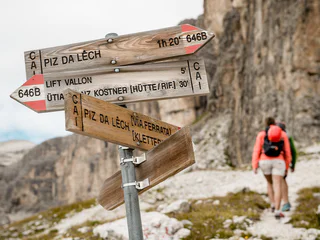
Fixed rope route from the Malga Oltradige up to the Mount Roen
Sella/Söll, Tramin an der Weinstraße/Termeno sulla Strada del Vino, Alto Adige Wine Road
Aim high in South Tyrol’s mountains. Securely attached to rope on one of our climbing routes called "via ferrata", you can reach peaks unattainable for normal hikers and conquer walls otherwise visible only from below. More than 50 vie ferrate run along South Tyrol’s most beautiful peaks, many of which are located in the Dolomites, a UNESCO World Heritage Site. In addition to a variety of difficulty levels and excellent sign-posting, the routes are checked on an annual basis to ensure a perfectly safe way to enjoy this form of climbing and the majestic scenery.

Sella/Söll, Tramin an der Weinstraße/Termeno sulla Strada del Vino, Alto Adige Wine Road

1/5
Colfosco/Colfosco, Corvara, Dolomites Region Alta Badia

Sesto/Sexten

San Cassiano/San Cassiano

Gandelle-Franadega-Fienili/Kandellen-Frondeigen-Stadlern, Toblach/Dobbiaco, Dolomites Region 3 Zinnen

1/6
Pescosta/Pescosta, Sëlva/Selva di Val Gardena, Dolomites Region Val Gardena

S. Maddalena/St. Magdalena - Funes/Villnöss, Villnöss/Funes, Dolomites Region Villnösstal

1/2
Colfosco/Colfosco, Corvara, Dolomites Region Alta Badia

Alpe di Siusi/Seiseralm, Kastelruth/Castelrotto, Dolomites Region Seiser Alm

1/4
Nova Levante/Welschnofen, Welschnofen/Nova Levante, Dolomites Region Eggental

1/2
Sesto/Sexten, Sexten/Sesto, Dolomites Region 3 Zinnen

Sesto/Sexten, Sexten/Sesto, Dolomites Region 3 Zinnen

Sesto/Sexten, Sexten/Sesto, Dolomites Region 3 Zinnen

1/6
Plata/Platt, Moos in Passeier/Moso in Passiria, Meran/Merano and environs

1/4
Nova Levante/Welschnofen

Sesto/Sexten, Sexten/Sesto, Dolomites Region 3 Zinnen

Sesto/Sexten

San Cassiano/San Cassiano

1/8
Alpe di Siusi/Seiseralm, Kastelruth/Castelrotto, Dolomites Region Seiser Alm

1/4
S.Cristina Gherdëina/S.Cristina Val Gardena/S.Cristina Gherdëina/St.Christina in Gröden, S.Crestina Gherdëina/Santa Cristina Val Gardana, Dolomites Region Val Gardena

1/3
Sesto/Sexten, Sexten/Sesto, Dolomites Region 3 Zinnen

1/6
Lutago/Luttach, Ahrntal/Valle Aurina, Ahrntal/Valle Aurina

1/5
Tramin an der Weinstraße/Termeno sulla Strada del Vino, Alto Adige Wine Road

Sesto/Sexten, Sexten/Sesto, Dolomites Region 3 Zinnen

San Cassiano/San Cassiano

1/10
Falzeben/Falzeben, Hafling/Avelengo, Meran/Merano and environs

1/3
Badia/Badia, Badia, Dolomites Region Alta Badia

S. Vito/St. Veit - Sesto/Sexten, Sexten/Sesto, Dolomites Region 3 Zinnen

San Cassiano/San Cassiano

1/4
Valdaora di Mezzo/Mitterolang, Olang/Valdaora, Dolomites Region Kronplatz/Plan de Corones